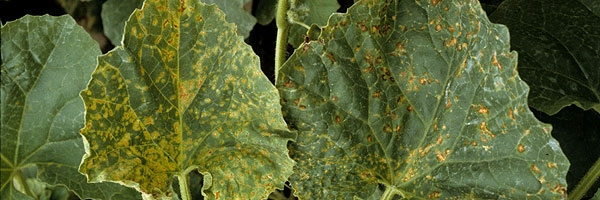
Melon necrotic spot virus (MNSV)
(Carmovirus, Tombusviridae)
MNSV is a fungus- carmovirus transmitted that causes necrotic-like disease in melon and cucumber. Zucchini and squash are not susceptible to this virus; the latter is generally not found in watermelon. However, a particular strain of MNSV has been associated with severe necrotic disease of this species in Crete.
This virus has been known for a very long time in early melon cultures in the South-East of France, where it has been called the "melon screening" virus, because of the characteristic symptoms it causes in this plant. MNSV is quite common in cultivation under cover (glass greenhouses, large tunnels), in the ground or in soilless cultivation, in early spring and autumn. On the other hand, the disease is only very rarely observed in open field crops in summer. During a survey carried out from 2004 to 2008 in the main French production areas, MNSV was only detected in melons, in 6% of the 1,400 samples analyzed. MNSV has been reported in many countries, sometimes associated with severe damage. In Japan, losses related to this virus have been estimated at 10% of the total production of a region.
The viral particles are paraspheric about 30 nm in diameter. The viral genome is a single-stranded RNA of positive polarity.
Symptoms caused by MNSV are similar to those caused by other viruses of the same type (see below) but also to bacterial, fungal attacks or burns due to phytotoxicities. It is therefore preferable to confirm the diagnosis by laboratory analyzes. Commercial diagnostic kits ELISA are available as well as primers for molecular diagnosis by RT-PCR.
Other viruses of the same type
Several other viruses transmitted by fungi cause necrotic syndromes on leaves and on stems in Cucurbitaceae. All of these viruses have a much larger host range than that of MNSV. They infect a large number of species belonging to botanical families other than the Cucurbitaceae under laboratory conditions. However, these viruses are very rarely encountered in crops and therefore do not present significant phytosanitary risks for the time being. Some of these viruses have been reported from time to time in France.
Thus, four viruses are transmitted by the fungus O. bornovanus . The Cucumber leaf spot virus ( CLSV, Aureusvirus , viruses foliar cucumber spots ) is also transmitted by the seed in the c oncombre; it has been reported from both southern and northern Europe. The Cucumber soil borne virus ( CSBV, Carmovirus , cucumber virus transmitted by the ground) has been reported in Lebanon. The Cucumber necrosis virus ( CNV, Tombusvirus , cucumber necrosis virus) has so far only been described in Canada. Finally, a necrotic type virus transmitted by O. bornovanus has been demonstrated in squash: the squash Squash necrosis virus necrosis virus (SqNV, Carmovirus , ). This virus has so far only been found in Brazil and Martinique.
It should be noted that certain strains of the Tobacco necrosis virus ( TNV, Necrovirus , tobacco necrosis virus) are generalized in cucumbers and cause damage in Holland, Great Britain and western France. They are transmitted by another species of Opidium , 0. brassicae .
Finally, the Petunia asteroid mosaic virus (PAMV, Tombusvirus , petunia star mosaic virus), the vector of which has not yet been identified, has been isolated, in the South-East of France, from cucumbers showing signs of generalized necrotic spots.
Only precise techniques, and in particular serological methods, currently make it possible to distinguish these viruses.





